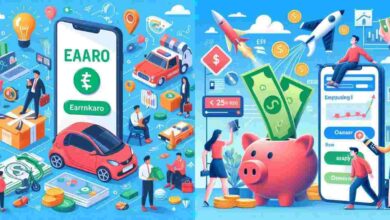Earn Money Without Leaving Home: Exploring the Top 10 Active Income Sources

Active income refers to the money earned through direct and active involvement in specific tasks or employment. It is the compensation you receive for the time and effort you put into a job, business, or freelance work. Unlike passive income, which comes from investments or assets, active income is directly correlated with the work you do.
This could include working a regular job where you receive a salary or hourly wage, freelancing or consulting, running your own business, or earning commissions through sales. Active income is typically predictable, consistent, and requires continuous effort. When you stop working or providing services, the income ceases. It forms the foundation of most people’s financial stability, covering everyday expenses, mortgages, and bills.
People actively participate in various forms of work to earn this type of income, trading their skills, time, and expertise for financial compensation. Examples include wages, earnings from self-employment, and fees for services rendered, all of which necessitate ongoing personal involvement to sustain the income flow.
Certainly, here’s a concise overview of the top 10 active income sources that you can pursue without leaving your home:
Freelancing:
Freelancing is a flexible and increasingly popular form of self-employment where individuals offer their specialized skills and services to clients or businesses on a contract basis. Freelancers, often referred to as independent contractors or consultants, work independently rather than as regular employees. They have the freedom to choose their projects, clients, and work schedules, allowing for greater work-life balance and autonomy.
Freelancing spans a wide range of professions, including writing, graphic design, programming, digital marketing, and more. Freelancers typically market themselves through online platforms like Upwork, Freelancer, or Fiverr, where they can bid on projects or connect with clients seeking specific services. This arrangement provides clients with access to a diverse pool of talent, and freelancers have the opportunity to diversify their income streams and potentially earn more than they would in a traditional job.
Freelancing offers flexibility, the chance to pursue passions, and the potential for financial independence, making it an appealing choice for many professionals seeking a non-traditional career path. However, it also comes with challenges such as inconsistent income, managing client relationships, and handling administrative tasks like invoicing and taxes.
Online Tutoring:
Online tutoring is an educational practice that has gained significant popularity in recent years, allowing students to receive personalized instruction and support remotely via the internet. In this digital learning environment, qualified tutors leverage various online platforms and tools to provide one-on-one or small group tutoring sessions to learners of all ages and academic levels.
These sessions cover a wide range of subjects, from mathematics and science to languages, test preparation, and specialized skills. Online tutoring offers several advantages, including flexibility in scheduling, accessibility for students worldwide, and the convenience of learning from the comfort of one’s home.
It also allows for a more personalized and tailored learning experience, as tutors can adapt their teaching methods to individual student needs. Additionally, it often proves to be a cost-effective alternative to traditional in-person tutoring services.
This mode of learning has gained prominence, especially in the wake of increased demand for remote education, and it continues to play a crucial role in enhancing educational opportunities for students worldwide.
Affiliate Marketing:
Affiliate marketing is a performance-based online marketing strategy where individuals, known as affiliates, partner with businesses or product owners to promote and sell their products or services. Affiliates earn a commission for every sale, click, or action generated through their marketing efforts.
This arrangement benefits all parties involved: the business gains more exposure and sales without the upfront costs of traditional advertising, the affiliate earns a share of the revenue for their promotional efforts, and consumers discover products or services that align with their interests or needs.
Affiliate marketing operates through unique tracking links or codes that affiliates use to drive traffic to the business’s website or product page. When a visitor makes a purchase or takes a desired action, the affiliate receives a predetermined commission, often a percentage of the sale. This system allows for transparency and accurate tracking of results.
Affiliate marketing is a popular income source for bloggers, content creators, social media influencers, and website owners. It provides an opportunity to monetize their platforms by recommending products or services they genuinely believe in. Successful affiliate marketers often focus on building trust with their audience and creating valuable, relevant content to drive conversions.
The affiliate marketing industry has grown significantly in the digital age, offering numerous opportunities for both businesses looking to expand their reach and individuals seeking to generate income online.
Blogging/Vlogging:
Blogging and vlogging are two closely related forms of content creation that have transformed the way information is shared and consumed on the internet. Blogging involves the creation of written content, typically in the form of articles or posts, published on a personal blog or website. Vlogging, on the other hand, stands for video blogging and revolves around the creation of video content, often shared on platforms like YouTube.
Bloggers and vloggers cover a vast array of topics, from travel and fashion to technology and education. They engage with their audience by sharing their knowledge, experiences, opinions, and insights in a particular niche or area of interest. What makes these forms of content creation unique is their ability to foster a sense of community and connection with readers or viewers who share similar interests.
Both bloggers and vloggers have the opportunity to monetize their content through various means, such as advertising, sponsorships, affiliate marketing, and even selling their products or services.
However, building a successful blog or vlog requires consistent effort, dedication, and the ability to create valuable, engaging, and relevant content that resonates with their target audience. Blogging and vlogging not only offer avenues for self-expression and creativity but also have the potential to generate substantial income for those who build a loyal and engaged following over time.
E-commerce (Dropshipping):
E-commerce, particularly through the dropshipping business model, has revolutionized the way products are bought and sold online. Dropshipping is an e-commerce method where online retailers, known as dropshippers, partner with suppliers to sell products directly to customers without holding inventory.
Instead of stocking and managing merchandise, the dropshipper’s role is to market and promote products, handle customer orders, and forward them to the supplier for fulfillment.
The dropshipping process typically begins when a customer places an order on the dropshipper’s website or online store. The dropshipper then purchases the product from their supplier, who ships it directly to the customer’s address. This model has several advantages, including minimal upfront investment, as there’s no need to purchase and store inventory, reduced overhead costs, and the ability to offer a wide variety of products without the hassle of managing a physical inventory.
Dropshipping allows entrepreneurs to start e-commerce businesses with relatively low risk and offers the flexibility to work from home or remotely. However, it also comes with challenges such as intense competition, thin profit margins, and the need to carefully manage supplier relationships and customer satisfaction. Despite these challenges, dropshipping remains a popular and viable option for individuals looking to enter the e-commerce space and build profitable online businesses.
Remote Customer Support:
Remote customer support refers to the practice of providing customer assistance and service from a remote location, typically from one’s home or another off-site location, rather than being physically present in a traditional office or call center.
This approach leverages technology such as the internet, telephones, chat software, and email to interact with customers and resolve their inquiries, issues, or concerns. Remote customer support representatives handle a wide range of tasks, including answering questions, troubleshooting technical problems, processing orders, and addressing complaints.
The remote customer support model offers several advantages, both for businesses and employees. For businesses, it can reduce overhead costs associated with maintaining physical call centers, while also enabling access to a broader talent pool since customer support agents can work from anywhere. For employees, it provides flexibility in work hours and location, allowing them to work from the comfort of their homes.
Remote customer support has gained particular prominence in recent years, as technological advancements have made it easier for businesses to implement and manage remote work arrangements.
Additionally, the COVID-19 pandemic accelerated the adoption of remote customer support as companies sought to ensure the safety of their employees and continued to provide uninterrupted service to their customers. This model has proven to be a valuable and efficient way to deliver customer service while offering a work-life balance that many employees find appealing.
Stock Photography:
Stock photography is a lucrative industry that revolves around the licensing and sale of high-quality images, photographs, and illustrations to individuals, businesses, and organizations seeking visual content for various purposes. Photographers, amateur or professional, contribute their work to stock photography agencies or websites, where the images are made available for purchase and download by customers. These images cover a wide range of subjects, including nature, travel, business, lifestyle, and more.
Stock photography offers numerous advantages for both photographers and customers. Photographers can earn a passive income by licensing their images multiple times to different buyers. For customers, it provides a cost-effective and convenient way to access a vast library of professionally captured visuals for use in marketing materials, websites, advertisements, publications, and more.
Stock photography agencies often categorize images based on keywords, making it easy for customers to search and find the specific visuals they need. While the income generated from individual image sales can be relatively small, successful stock photographers who contribute a substantial number of high-quality images to multiple platforms can create a steady stream of income over time. Stock photography remains a valuable resource for businesses and individuals seeking eye-catching visuals to enhance their projects and marketing efforts.
Podcasting:
Podcasting is a popular and rapidly growing form of digital media that revolves around creating and distributing audio or video content on the internet. Unlike traditional radio or television, podcasts are on-demand and can be accessed and consumed at the listener’s convenience. Podcasts cover a wide range of topics, including news, entertainment, education, storytelling, technology, and more. They are typically episodic, with new episodes released on a regular schedule.
Podcasting has become an accessible platform for content creators and enthusiasts, allowing individuals and organizations to share their ideas, expertise, and stories with a global audience. Podcasters can produce their shows with relatively modest equipment and easily distribute them through podcast hosting platforms like Apple Podcasts, Spotify, Google Podcasts, and many others.
Listeners can subscribe to their favorite podcasts, automatically downloading new episodes as they become available, making it easy to stay updated on topics of interest. The format encourages engagement and fosters a sense of community, as audiences often connect with podcast hosts and fellow listeners through social media and online discussions.
Podcasting offers various opportunities, from entertainment and education to marketing and brand building. Many podcasts generate revenue through advertising, sponsorships, listener donations, or premium subscription models. With its low barrier to entry and the ability to reach niche audiences, podcasting continues to thrive as a versatile and influential medium in the digital age.
Content Creation (Writing, Design, Video Editing):
Content creation encompasses a broad spectrum of creative endeavors, including writing, graphic design, and video editing. It involves the process of conceptualizing, producing, and delivering various forms of digital content for diverse purposes and audiences.
Writing involves crafting engaging and informative written material, such as articles, blog posts, web content, marketing copy, and more. Talented writers can convey ideas, stories, and information effectively, capturing the attention of readers and conveying messages with clarity and impact.
Graphic design focuses on visual communication, where designers use their creative skills to craft visually appealing and purposeful graphics, illustrations, and layouts. Graphic designers play a critical role in branding, marketing, and web design, creating eye-catching visuals that enhance the overall user experience.
Video editing combines storytelling and technical expertise to create compelling video content. Video editors work with raw footage, adding effects, transitions, music, and text to create polished and engaging videos. Video content has gained significant traction in today’s digital landscape, becoming a powerful medium for conveying information and entertainment.
Content creators in these fields often work in various industries, including media, marketing, advertising, education, and entertainment. They use their skills to engage audiences, promote products or services, convey information, and share ideas. In an era dominated by digital media, the work of content creators is crucial for effective communication, branding, and engagement with a global audience across various online platforms.
Online Surveys and Reviews:
Online surveys and reviews are essential tools for gathering feedback, opinions, and insights from individuals about products, services, or various topics. Online surveys typically involve structured sets of questions designed to collect specific information or measure sentiments on a particular subject. These surveys can range from customer satisfaction surveys for businesses to academic research questionnaires.
On the other hand, online reviews involve individuals sharing their personal experiences and assessments of products, services, or experiences on platforms like Amazon, TripAdvisor, Yelp, and social media. Reviews often include written feedback, star ratings, and sometimes photos or videos.
For businesses, online surveys and reviews serve as valuable sources of customer feedback, helping them understand customer preferences, identify areas for improvement, and make data-driven decisions. Consumers, on the other hand, rely on online reviews to make informed choices when purchasing products or services, whether it’s choosing a restaurant, booking a hotel, or buying a new gadget.
In both cases, transparency and authenticity are crucial, as consumers and businesses alike value honest and unbiased opinions. Online surveys and reviews have become integral to decision-making processes in today’s digital age, shaping the reputations of businesses and influencing consumers’ purchasing choices.
These active income sources provide various opportunities for individuals to earn money from the convenience of their homes, offering flexibility and the potential for financial independence.
Conclusion:
In conclusion, the top 10 active income sources provide a diverse array of opportunities for individuals seeking to earn money while actively participating in work or business ventures. These sources encompass a wide range of skills, interests, and industries, allowing individuals to choose paths that align with their expertise and passions.
Whether it’s through freelancing, consulting, tutoring, affiliate marketing, or any of the other active income sources, individuals have the potential to generate income, gain financial independence, and achieve their financial goals. However, it’s important to note that active income often requires consistent effort and time commitment, and the level of success can vary based on individual dedication and market conditions.
Regardless, the opportunities presented by these income sources continue to evolve and adapt in our ever-changing digital world, making it possible for individuals to thrive in various ways while actively participating in their chosen fields.




